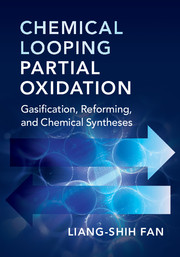Book contents
- Frontmatter
- Dedication
- Epigraph
- Contents
- In Cooperation with Professor Fan's Research Group Members
- Preface
- Nomenclature
- Abbreviations
- 1 Overview
- 2 Metal Oxide Oxygen Carriers
- 3 Oxidative Coupling of Methane
- 4 Syngas Generation
- 5 Catalytic Metal Oxides and Applications
- 6 Process Simulations and Techno-Economic Analyses
- Index
- Color plate section
5 - Catalytic Metal Oxides and Applications
Published online by Cambridge University Press: 07 November 2017
- Frontmatter
- Dedication
- Epigraph
- Contents
- In Cooperation with Professor Fan's Research Group Members
- Preface
- Nomenclature
- Abbreviations
- 1 Overview
- 2 Metal Oxide Oxygen Carriers
- 3 Oxidative Coupling of Methane
- 4 Syngas Generation
- 5 Catalytic Metal Oxides and Applications
- 6 Process Simulations and Techno-Economic Analyses
- Index
- Color plate section
Summary
Introduction
Selective oxidation reactions of carbon based feedstocks synthesize important chemicals and their precursors, such as alcohols, epoxides, aldehydes, and other organic compounds. They employ catalytic metal oxides, which are multifunctional, enabling materials, to fulfill three parallel roles: (1) provide active surface sites for the reactants without participating in the reaction; (2) reduce the activation energies of the reaction pathway; and (3) oxidize the reactants through the transfer of their lattice oxygen during reduction. The third role is akin to the well-known catalytic surface Mars–Van Krevelen mechanism, which is further discussed in this section and Section 5.6, that is characterized by the reaction products incorporating the compounds of the catalytic material lattice. In these kinds of selective oxidation reactions, the catalytic metal oxides behave as “oxygen carriers,” where oxygen from the crystal lattice bonds with the reactants. In these reactions, the surface of the metal oxide is reduced by the hydrocarbon reactant and can later be re-oxidized by gaseous oxygen.
The selectivity of a catalytic metal oxide can be controlled by multiple factors, such as structure, chemistry, electronic properties, composition, kinetics, and energies. An ideal selective catalytic metal oxide needs to be tailored specifically for the application at hand. Hence, it becomes essential to understand the surface morphology, crystal structure, and the reaction mechanisms involved. The accessibility and mobility of lattice oxygen play a vital role in determining the reactivity and selectivity of the catalytic metal oxides. The structure of the catalytic metal oxide should allow for sufficient transportation of lattice oxygen toward the surface and needs to be able to sustain the vacancy created by the absence of oxygen. That is, the host structure needs to provide a sustainable pathway for the ions to diffuse in order to utilize the lattice oxygen. While participation of lattice oxygen facilitates the oxidation–reduction of the process, it does not necessarily result in high product selectivity. The selectivity of a given structure can originate from the bond strength between metal and oxygen, where a weak metal–oxygen bond will release oxygen that can fully oxidize the reactant and yield an undesired product. An ideal catalytic metal oxide with readily accessible and mobile lattice oxygen, appropriate host structure, and suitable metal–oxygen bond strength has the potential to be both reactive and selective when reduced.
- Type
- Chapter
- Information
- Chemical Looping Partial OxidationGasification, Reforming, and Chemical Syntheses, pp. 307 - 369Publisher: Cambridge University PressPrint publication year: 2017



